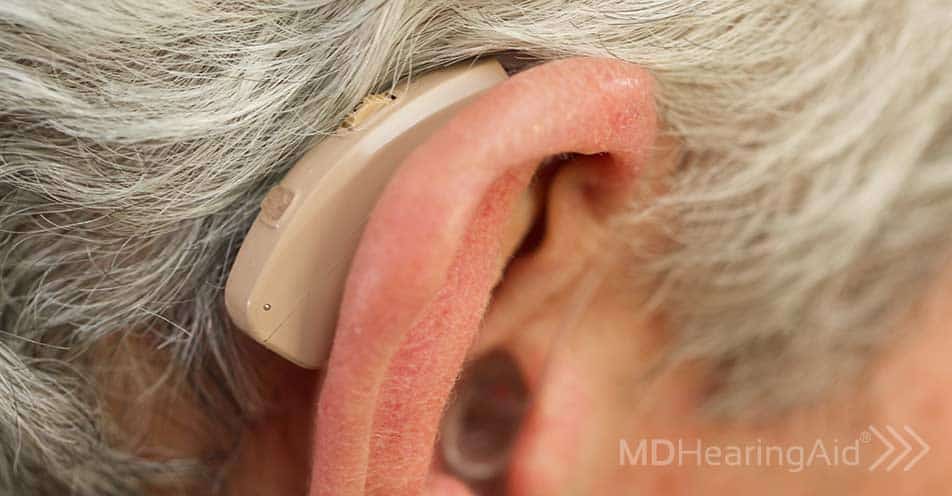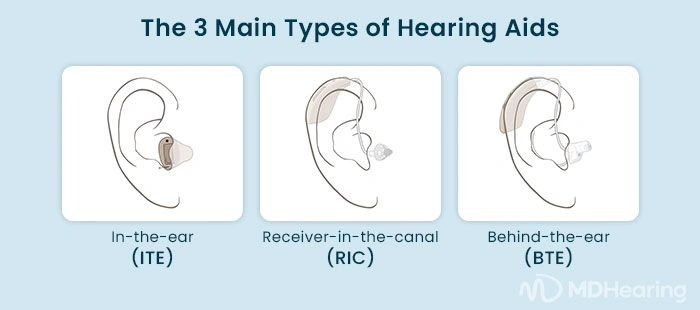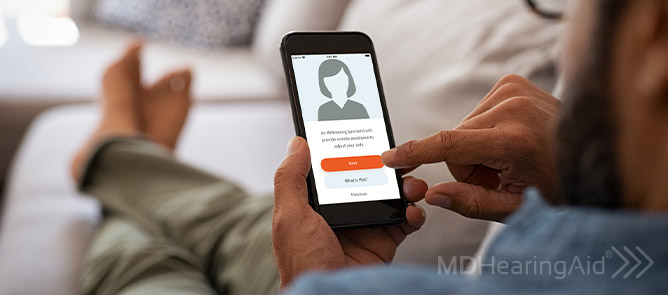Find better deals on high-quality hearing aids by learning the basics.
Hearing aids work like magic to restore your ability to understand conversations, enjoy parties, and listen to your favorite music or shows again. But how do they actually get the job done? What technology do they have inside them—and is there a difference between expensive hearing aids and affordable ones?
In this quick guide to how hearing aids work, we’ll explain the basics. Not only will we demystify the hearing aid, but we will show an important difference between real and “fake” hearing aids. This will help you find quality hearing aids while shopping for deals on the internet.
Please use the following links to navigate this guide:
- Real Hearing Aids vs. Fake Hearing Aids: An Important Difference
- How Hearing Aids Work: The Basics
- The Main Components of Hearing Aids
- The 3 Design Styles of Hearing Aids
- Analog vs. Digital Hearing Aids
- Advanced Hearing Aids Functionality
- Quality Hearing Aids Don't Have to Be Expensive
Real Hearing Aids vs. Fake Hearing Aids: An Important Difference
We all know that hearing aids amplify sound. But did you know that real hearing aids focus on amplifying the specific sounds and frequencies affected by hearing loss?
In fact, devices that amplify all sounds and frequencies equally are not real hearing aids (according to the FDA). They are PSAPs (personal sound amplification products) and they aren't designed to treat hearing loss.
Remember this when shopping for affordable hearing aids: There are a lot of cheap devices that look like hearing aids but they’re only PSAPs. They are not intended for hearing loss.
What Are PSAPs?
According to the FDA, PSAPs “are intended for consumers with no hearing loss who want to make environmental sounds louder, such as for recreational activities like birdwatching or hunting... PSAPs are not medical devices.”
You can usually identify PSAPs by price alone—as they are generally between $20 and $100 a pair. But sometimes, they can be more expensive when sellers unlawfully market them as hearing aids. This is confusing for consumers who are shopping for deals.
Don’t be fooled by sound amplifiers or PSAPs. They do not provide clear hearing experiences for people with hearing loss. In most cases, all you get is an irritating, tinny, and unintelligible jumble of sounds.
Always Buy FDA-Registered Hearing Aids (Not PSAPs)
According to FDA rules, hearing aids “are intended for use by people with hearing loss.” Most hearing loss patients have trouble hearing sound frequencies between 2,000 Hz and 8,000 Hz. So, a real set of hearing aids will focus on amplifying those frequencies for most patients. Or, an audiologist will custom tune the hearing aid based on a professional hearing test.
In addition to basic hearing loss treatment, more advanced hearing aids include exciting features and technology to improve control, performance, comfort, and ease-of-use.
Compare and contrast the features of different MDHearing models here.
The best way to know that you’re buying a real set of hearing aids—and the best way to avoid getting scammed—is to check if they are “FDA-registered hearing aids.” Start by looking at the company’s website to see if they say the devices are FDA registered. Next, find the FDA registration number. To be certain, search for the manufacturer on the FDA hearing aid registration website to make sure that the registration is current.
To stay safe, hearing loss patients should avoid all hearing aids that do not have FDA registration—and you should carefully investigate any hearing aid selling for less than $200 a pair. Finally, only purchase hearing aids that come with a full, money-back guarantee—even if you buy them at a hearing clinic.
Every hearing loss patient has different needs, and every hearing aid is different, so don't put yourself in a position where you are stuck with a pair of hearing aids you don't like.
How Hearing Aids Work: The Basics
Understanding how hearing aids work starts with understanding how hearing loss happens. Most patients with hearing loss have permanently damaged hair cells. Hair cells are found deep in the ear. They pick up sound vibrations, turn them into electrical signals, and send them to the brain.
In most cases, hair cell damage is a natural part of getting older—but hair cell damage can also happen as a result of loud noise exposure, infection, or disease. The more hair cell damage you have, the harder it is to hear. Voices and other sounds become muffled and difficult to understand. Most hearing loss patients still have hair cells that work, but they’re not as sensitive as they used to be. This is where hearing aids can help.
Hearing aids pick up the sounds and vibrations around you with a microphone. Then they use an amplifier to process and magnify the specific sound frequencies you can’t hear. From there, the hearing aid receiver sends the amplified sounds to your ear. The amplification makes it easier for damaged hair cells to detect the sound signals and send them to the brain.
The Main Components of Hearing Aids
Let’s review the three main components of a hearing aid:
- Microphone: The microphone picks up sound vibrations. Entry hearing aids often have only one microphone per aid. More technologically advanced hearing aids have dual-directional microphones, which focus your hearing on sounds coming from a specific location (i.e., the person in front of you). This provides clearer hearing in noisy environments.
- Amplifier: The amplifier processes and magnifies the specific sound frequencies you can’t hear and sends the amplified sound signal to the receiver. Advanced hearing aids include digital sound processors that help clarify and amplify the most important sounds in complex listening scenarios.
- Receiver: The “receiver” is another word for the “speaker.” This component delivers the amplified sound to your ears. In some hearing aid styles, the speaker is found in an earpiece that goes in the ear. In others, the speaker sends sound to the ear through a clear plastic tube.
The 3 Design Styles of Hearing Aids
There are three main design styles of hearing aids. Depending on the design, they are worn either behind or in the ear.
1. In-the-ear (ITE) Hearing Aids
Some in-the-ear (ITE) hearing aids disappear completely in the ear canal, while others hide partially in the ear canal and are still somewhat visible. Some in-the-ear aids are larger and rest visibly in the bowl of the ear. In any case, ITE hearing aids tend to be very small, so it can be tricky to adjust their settings and keep them clean.
Due to their small size, ITE aids may not be able to provide enough amplification for those with severe hearing loss.
2. Receiver-in-Canal (RIC) Hearing Aids
Receiver-in-canal (RIC) styles place most of the hearing aid components behind-the-ear except for the receiver (speaker), which inserts into the ear and connects to the hearing aid with a tiny wire. These hearing aids provide a wearing experience that is similar to BTE hearing aids.
In some cases, RIC hearing aids can minimize sound distortion compared to BTEs. However, they are not as durable and long-lasting as BTE hearing aids (see next section), and they require additional maintenance. For example, the tiny speaker in the ear is vulnerable to damage from wax buildup. Also, the wire and receiver that attach the hearing aid could break and may require replacement after several years of use.
3. Behind-the-Ear (BTE) Hearing Aids
Behind-the-ear hearing aids also rest behind the ear. However, instead of a wire, these hearing aids feature a clear, almost invisible tube that channels sound into an earpiece. Because they sit behind the ear, these hearing aids have extra room for more powerful speakers—which is great for people who need more amplification.
Modern behind-the-ear hearing aids are still extremely small. They hide behind the ear in a way that is nearly undetectable.
At MDHearing, majority of our hearing aids are BTE models. Our design engineers have found that the BTE style is more durable, longer-lasting, and requires less maintenance. Furthermore, the style offers an easier-to-assemble construction process and a more strategic spacing of components. This allows us to dramatically reduce the cost of manufacturing and assembly—then we transfer the savings to you!
The rugged durability and affordability of manufacturing BTE hearing aids offer the perfect balance of high-quality hearing care and affordability for our customers.
Analog vs. Digital Hearing Aids
Today, most hearing aids are digital, but some are still analog. In this section, we’ll learn the difference.
Analog Hearing Aids
Until about the mid-1990s, all hearing aids used analog technology. These hearing aids are simpler than the digital hearing aids of today. Analog hearing aids convert sound waves into electrical signals and amplify specific sound frequencies before sending them to the ear.
Analog hearing aids cannot reduce background noise the way digital aids do. However, some professional musicians and music buffs prefer the listening experience of analog—for the same reason that some music fans prefer listening to old vinyl records. You can still find analog hearing aids today—but they are not as common as digital aids.
Digital Hearing Aids
Digital hearing aids convert sound waves into digital codes. The digital codes include information about the direction, pitch, and volume of sounds. This allows digital hearing aids to achieve incredible levels of sound clarity—by making subtle adjustments to the volume and pitch of different sounds.
Digital hearing aids can also make precise adjustments for a wide range of listening situations—such as quiet rooms, noisy restaurants, TV watching, church, family dinners, or movie theaters.
Many digital hearing aids adjust their sound settings automatically as the listening conditions change around you. This offers a fluid and natural listening experience. The MDHearing VOLT MAX uses adaptive directional microphones to offer this feature.
Advanced Hearing Aid Functionality
Now that you understand the basics of how hearing aids work, let’s look at the advanced features available in modern hearing aids. Some of these features provide better controls for adjusting the settings of your hearing aids. Others improve the performance, comfort, ease of use, and convenience of your aids.
- Dual directional microphones: These are essential to helping hearing loss patients understand conversations in noisy environments. Dual directional microphones focus your hearing on an area directly in front of you, so you can listen to the person you’re talking to. Change directionality by turning your head, and focusing your listening on another person. Both the MDHearing VOLT and VOLT MAX include dual-directional microphones.
- Multiple listening program settings: These allow users to cycle through different listening programs for the clearest sound experience in different scenarios. Many digital hearing aids feature program settings for different listening conditions (i.e., quiet, social, noisy).
- Automatic sound environment sensing and adjustment: This feature enables digital hearing aids to monitor sound conditions and automatically adjust their sound processing settings for optimal listening in a variety of environments, such as restaurants, at home, or at a church event. The MDHearing VOLT MAX features automatic sound environment adjustments like this. Users enjoy a more fluid and natural listening experience—usually forgetting they are wearing hearing aids until taking them off at bedtime.
- Quick-response advanced feedback reduction: Most hearing aid wearers are familiar with the loud feedback (or whistling) noises they hear while inserting and removing their hearing aids. Feedback reduction minimizes or eliminates these annoying sounds for a more comfortable and relaxing hearing aid experience. All MDHearing devices offer feedback reduction technology.
- Hearing aid apps: Hearing aid apps are smartphone apps that allow you to remotely control the volume and other settings on your hearing aids. The most advanced hearing aids even allow a hearing aid specialist to remotely fine-tune the sound settings on your hearing aids from a distance. Hearing loss patients can order the MDHearing VOLT MAX online or over the phone. Then, an MDHearing professional can adjust their VOLT MAX according to the results of a professional hearing test. This allows patients to receive the same high level of care they would receive at a hearing clinic—but they never have to leave their homes to get it! (The times they are a-changin').
- Rechargeable hearing aids: Many hearing aids use tiny, replaceable batteries for power. While it’s easy to keep a pair of replacement batteries in your pocket, some users prefer rechargeable hearing aids. These models offer the convenience of not worrying about having replacement batteries on hand. They are also a good match for patients who may have trouble replacing batteries in non-rechargeable models due to dexterity issues.
Why Quality Hearing Aids Don’t Have to Be Expensive
Most patients discover they need hearing aids after going to a hearing clinic for a test. But hearing aids at hearing clinics are expensive enough to give the average American anxiety—costing anywhere from $2,500 to $8,000 a pair!
Clinics tell patients that the high cost of hearing aids is necessary, and paying their high prices is the only way to get a quality set of quality aids.
But we take a different approach at MDHearing. Every design consideration and business decision we implement has the fundamental goal of balancing quality and affordability into a single package. Our mission is to bring the price of hearing aids down to earth.
Here's how we do it:
- We design and build our own hearing aids with our own processors. This allows us to eliminate the unreasonable markups of hearing aid manufacturers. It has also empowered our engineers to implement innovative and cost-cutting solutions in our designing and building process—to save our customers thousands of dollars a pair on hearing aids.
- We sell our hearing aids directly to consumers over the internet. This empowers us to eliminate the hearing clinic markups, in addition to eliminating the high cost of running a brick-and-mortar store location and all of the wages of the employees and doctors that a clinic requires.
- We provide hearing clinic level care without the clinic. If you purchase the MDHearing VOLT MAX, our hearing professionals can remotely tune your hearing aids according to your specific needs. Patients can also consult with our on-staff audiologists for free to receive guidance on their hearing treatment options. MDHearing's ability to provide telehealth hearing care like this is radically transforming the way patients treat hearing loss—making quality care available to millions who couldn't otherwise afford it.
- We offer smartphone app tuning and adjustments. The MDHearing app gives VOLT MAX patients the freedom to remotely control their hearing aids. The app can also take you through a hearing check and automatically tune your hearing aids based on the results.
- We provide a FREE online hearing check. To check for the possibility of hearing loss, you can skip the clinic and take our free online hearing test to determine if you’re a good match for hearing aids from MDHearing.
By taking these and other steps to ensure quality and affordability, MDHearing has slashed the prices of quality hearing care down to as low as $299.98 a pair.
MDHearing: Quality and Affordability You Can Trust
We know MDHearing isn’t the only direct-to-consumer hearing aid on the market—so we want to thank you for taking the time to read this article, and spend this time with us. We hope you’ll consider us while evaluating which online hearing aid is best for your needs.
As for investigating what's out there, you should now have all of the basic understanding you need regarding how hearing aids work—and what you should look for in a high-quality, affordable set of aids.
If you’d like a no-risk, 45-day trial of any MDHearing model, we welcome you to order a pair. If they don’t work out, just send them back to us for a full refund!
Want to learn more about our FDA-registered hearing aid options?
BROWSE HEARING AIDS



